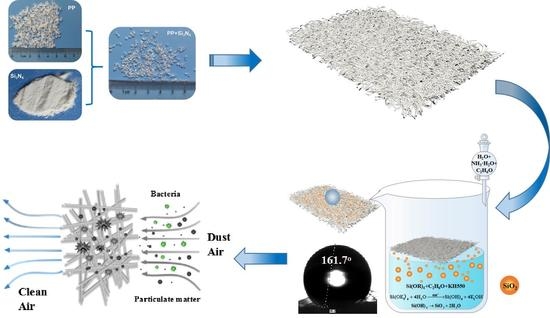Single-Side Superhydrophobicity in Si3N4-Doped and SiO2-Treated Polypropylene Nonwoven Webs with Antibacterial Activity
Abstract
:1. Introduction
2. Experimental
2.1. Materials
2.2. Preparation of PP/Si3N4 Antibacterial Pellets for MB
2.3. Preparation of Antibacterial MB Nonwovens
2.4. Superhydrophobic Finishing on One Side of As-Prepared Nonwovens
2.5. Morphologies, Structures and Properties
2.6. Filtration Test
2.7. Antibacterial Test
3. Results and Discussion
3.1. Fiber Morphologies, Structures and Properties of MB Nonwovens
3.2. Contact Angles (CAs) of MB Nonwovens
3.3. Thermal Properties of MB Nonwovens
3.4. Structures Analysis (FT-IR) of MB Nonwovens
3.5. Pore Size and Air Permeability
3.6. Filtration Performance
3.7. Antibacterial Properties
4. Conclusions
Supplementary Materials
Author Contributions
Funding
Institutional Review Board Statement
Informed Consent Statement
Data Availability Statement
Acknowledgments
Conflicts of Interest
References
- Kwong, L.H.; Wilson, R.; Kumar, S.; Crider, Y.S.; Sanchez, Y.R.; Rempel, D.; Pillarisetti, A. Review of the Breathability and Filtration Efficiency of Common Household Materials for Face Masks. ACS Nano 2021, 15, 5904–5924. [Google Scholar] [CrossRef] [PubMed]
- Hill, W.C.; Hull, M.S.; MacCuspie, R.I. Testing of Commercial Masks and Respirators and Cotton Mask Insert Materials using SARS-CoV-2 Virion-Sized Particulates: Comparison of Ideal Aerosol Filtration Efficiency versus Fitted Filtration Efficiency. Nano Lett. 2020, 20, 7642–7647. [Google Scholar] [CrossRef] [PubMed]
- Kwon, S.; Zambrano, M.C.; Venditti, R.A.; Frazier, R.; Zambrano, F.; Gonzalez, R.W.; Pawlak, J.J. Microfiber shedding from nonwoven materials including wipes and meltblown nonwovens in air and water environments. Environ. Sci. Pollut. Res. 2022. [Google Scholar] [CrossRef]
- Jayaweera, M.; Perera, H.; Gunawardana, B.; Manatunge, J. Transmission of COVID-19 virus by droplets and aerosols: A critical review on the unresolved dichotomy. Environ. Res. 2020, 188, 109819. [Google Scholar] [CrossRef]
- Zhao, L.; Qi, Y.H.; Luzzatto-Fegiz, P.; Cui, Y.; Zhu, Y.Y. COVID-19: Effects of Environmental Conditions on the Propagation of Respiratory Droplets. Nano Lett. 2020, 20, 7744–7750. [Google Scholar] [CrossRef]
- Kohanski, M.A.; Lo, L.J.; Waring, M.S. Review of indoor aerosol generation, transport, and control in the context of COVID-19. Int. Forum Allergy Rhinol. 2020, 10, 1173–1179. [Google Scholar] [CrossRef]
- Geng, Q.; Pu, Y.; Li, Y.; Yang, X.; Wu, H.; Dong, S.; Yuan, D.; Ning, X. Multi-component nanofiber composite membrane enabled high PM0.3 removal efficiency and oil/water separation performance in complex environment. J. Hazard. Mater. 2022, 422, 126835. [Google Scholar] [CrossRef]
- Deng, C.; Seidi, F.; Yong, Q.; Jin, X.; Li, C.; Zhang, X.; Han, J.; Liu, Y.; Huang, Y.; Wang, Y.; et al. Antiviral/antibacterial biodegradable cellulose nonwovens as environmentally friendly and bioprotective materials with potential to minimize microplastic pollution. J. Hazard. Mater. 2022, 424, 127391. [Google Scholar] [CrossRef] [PubMed]
- Chughtai, A.A.; Stelzer-Braid, S.; Rawlinson, W.; Pontivivo, G.; Wang, Q.; Pan, Y.; Zhang, D.; Zhang, Y.; Li, L.; MacIntyre, C.R. Contamination by respiratory viruses on outer surface of medical masks used by hospital healthcare workers. BMC Infect. Dis. 2019, 19, 491. [Google Scholar] [CrossRef] [PubMed] [Green Version]
- Shimasaki, N.; Okaue, A.; Kikuno, R.; Shinohara, K. Comparison of the Filter Efficiency of Medical Nonwoven Fabrics against Three Different Microbe Aerosols. Biocontrol Sci. 2018, 23, 61–69. [Google Scholar] [CrossRef] [PubMed] [Green Version]
- Luksamijarulkul, P.; Aiempradit, N.; Vatanasomboon, P. Microbial Contamination on Used Surgical Masks among Hospital Personnel and Microbial Air Quality in their Working Wards: A Hospital in Bangkok. Oman Med. J. 2014, 29, 346–350. [Google Scholar] [CrossRef] [PubMed]
- Huang, W.; Leonas, K.K. Evaluating a one-bath process for imparting antimicrobial activity and repellency to nonwoven surgical gown fabrics. Text. Res. J. 2000, 70, 774–784. [Google Scholar] [CrossRef]
- Wang, Z.; Wang, D.; Zhu, Z.; Li, W.; Xie, Y. Enhanced antistatic properties of polyethylene film/polypropylene-coated non-woven fabrics by compound of hot-melt adhesive and polymer antistatic agent. J. Ind. Text. 2021, 50, 921–938. [Google Scholar] [CrossRef]
- Wang, X.; Huang, Z.; Miao, D.; Zhao, J.; Yu, J.; Ding, B. Biomimetic fibrous murray membranes with ultrafast water transport and evaporation for smart moisture-wicking fabrics. ACS Nano 2018, 13, 1060–1070. [Google Scholar] [CrossRef]
- Miao, D.; Cheng, N.; Wang, X.; Yu, J.; Ding, B. Integration of Janus Wettability and Heat Conduction in Hierarchically Designed Textiles for All-Day Personal Radiative Cooling. Nano Lett. 2022, 22, 680–687. [Google Scholar] [CrossRef]
- Liu, X.L.; Gu, Y.C.; Mi, T.F.; Zhao, Y.H.; Wang, X.M.; Zhang, X. Preparation of Superhydrophobic Fabric Based on the SiO2@PDFMA Nanocomposites by an Emulsion Graft Polymerization and a Hot-Pressing Process. ChemistrySelect 2021, 6, 5646–5654. [Google Scholar] [CrossRef]
- Hou, C.M.; Cao, C.J. Superhydrophobic cotton fabric membrane prepared by fluoropolymers and modified nano-SiO2 used for oil/water separation. RSC Adv. 2021, 11, 31675–31687. [Google Scholar] [CrossRef]
- Erdogan, S. Textile Finishing with Chitosan and Silver Nanoparticles Against Escherichia coli Atcc 8739. Trak. Univ. J. Nat. Sci. 2020, 21, 21–32. [Google Scholar] [CrossRef] [Green Version]
- Anwar, Y.; Alghamdi, K.M. Imparting antibacterial, antifungal and catalytic properties to cotton cloth surface via green route. Polym. Test 2019, 81, 106258. [Google Scholar] [CrossRef]
- Hamouda, T.; Ibrahim, H.M.; Kafafy, H.H.; Mashaly, H.M.; Mohamed, N.H.; Aly, N.M. Preparation of cellulose-based wipes treated with antimicrobial and antiviral silver nanoparticles as novel effective high-performance coronavirus fighter. Int. J. Biol. Macromol. 2021, 181, 990–1002. [Google Scholar] [CrossRef]
- Zhang, G.; Wang, D.; Xiao, Y.; Dai, J.; Zhang, W.; Zhang, Y. Fabrication of Ag Np-coated wetlace nonwoven fabric based on amino-terminated hyperbranched polymer. Nanotechnol. Rev. 2019, 8, 100–106. [Google Scholar] [CrossRef]
- Di, Y.; Li, Q.; Zhuang, X. Antibacterial finishing of Tencel/cotton nonwoven fabric using Ag nanoparticles-chitosan composite. J. Eng. Fibers. Fabr. 2012, 7, 24–29. [Google Scholar] [CrossRef] [Green Version]
- Gadkari, R.R.; Ali, W.; Das, A.; Alagirusamy, R. Configuration of a unique antibacterial needle-punched nonwoven fabric from silver impregnated polyester nanocomposite fibres. J. Ind. Text. 2020, 1–17. [Google Scholar] [CrossRef]
- Amiri, S.; Duroux, L.; Nielsen, J.L.; Nielsen, A.H.; Yu, D.; Larsen, K.L. Preparation and characterization of a temperature-sensitive nonwoven poly (propylene) with antibacterial properties. J. Text. Inst. 2014, 105, 327–336. [Google Scholar] [CrossRef]
- Shao, D.; Wei, Q.; Tao, L.; Zhu, H.; Ge, M. Preparation and characterization of pet nonwoven coated with ZnO-Ag by one-pot hydrothermal techniques. Tekst. Konfeksiyon 2013, 23, 338–341. [Google Scholar]
- Shiu, B.C.; Zhang, Y.; Yuan, Q.; Lin, J.H.; Lou, C.W.; Li, Y. Preparation of Ag@ ZIF-8@ PP Melt-Blown Nonwoven Fabrics: Air Filter Efficacy and Antibacterial Effect. Polymers 2021, 13, 3773. [Google Scholar] [CrossRef] [PubMed]
- Li, T.T.; Fan, Y.; Cen, X.; Wang, Y.; Shiu, B.C.; Ren, H.T.; Peng, H.K.; Jiang, Q.; Lou, C.W.; Lin, J.H. Polypropylene/polyvinyl alcohol/metal-organic framework-based melt-blown electrospun composite membranes for highly efficient filtration of PM2. Nanomaterials 2020, 10, 2025. [Google Scholar] [CrossRef]
- Liu, C.; Liu, J.; Ning, X.; Chen, S.; Liu, Z.; Jiang, S.; Miao, D. The effect of polydopamine on an Ag-coated polypropylene nonwoven fabric. Polymers 2019, 11, 627. [Google Scholar] [CrossRef] [Green Version]
- Kang, Y.O.; Im, J.N.; Park, W.H. Morphological and permeable properties of antibacterial double-layered composite nonwovens consisting of microfibers and nanofibers. Compos. Part B Eng. 2015, 75, 256–263. [Google Scholar] [CrossRef]
- Makowski, T.; Svyntkivska, M.; Piorkowska, E.; Kregiel, D. Multifunctional polylactide nonwovens with 3D network of multiwall carbon nanotubes. Appl. Surf. Sci. 2020, 527, 146898. [Google Scholar] [CrossRef]
- Li, Q.S.; He, H.W.; Fan, Z.Z.; Zhao, R.H.; Chen, F.X.; Zhou, R.; Ning, X. Preparation and performance of ultra-fine polypropylene antibacterial fibers via melt electrospinning. Polymers 2020, 12, 606. [Google Scholar] [CrossRef] [PubMed] [Green Version]
- Krutyakov, Y.A.; Kudrinskiy, A.A.; Kuzmin, V.A.; Pyee, J.; Gusev, A.A.; Vasyukova, I.A.; Zakharova, O.V.; Lisichkin, G.V. In Vivo Study of Entero-and Hepatotoxicity of Silver Nanoparticles Stabilized with Benzyldimethyl-[3-myristoylamine)-propyl] ammonium Chloride (Miramistin) to CBF1 Mice upon Enteral Administration. Nanomaterials 2021, 11, 332. [Google Scholar] [CrossRef] [PubMed]
- Zhang, S.; Du, C.; Wang, Z.; Han, X.; Zhang, K.; Liu, L. Reduced cytotoxicity of silver ions to mammalian cells at high concentration due to the formation of silver chloride. Toxicol Vitr. 2013, 27, 739–744. [Google Scholar] [CrossRef] [PubMed] [Green Version]
- Zanocco, M.; Marin, E.; Boschetto, F.; Adachi, T.; Yamamoto, T.; Kanamura, N.; Zhu, W.L.; McEntire, B.J.; Bal, B.S.; Ashida, R.; et al. Surface Functionalization of Polyethylene by Silicon Nitride Laser Cladding. Appl. Sci. 2020, 10, 2612. [Google Scholar] [CrossRef] [Green Version]
- Pezzotti, G.; Marin, E.; Adachi, T.; Lerussi, F.; Rondinella, A.; Boschetto, F.; Zhu, W.L.; Kitajima, T.; Inada, K.; McEntire, B.J.; et al. Incorporating Si3N4 into PEEK to produce antibacterial, osteocondutive, and radiolucent spinal implants. Macromol. Biosci. 2018, 18, 1800033. [Google Scholar] [CrossRef]
- Pezzotti, G.; Bock, R.M.; McEntire, B.J.; Jones, E.; Boffelli, M.; Zhu, W.; Baggio, G.; Boschetto, F.; Puppulin, L.; Adachi, T.; et al. Silicon nitride bioceramics induce chemically driven lysis in Porphyromonas gingivalis. Langmuir 2016, 32, 3024–3035. [Google Scholar] [CrossRef]
- Boschetto, F.; Toyama, N.; Horiguchi, S.; Bock, R.M.; McEntire, B.J.; Adachi, T.; Marin, E.; Zhu, W.L.; Mazda, O.; Bal, B.S.; et al. In vitro antibacterial activity of oxide and non-oxide bioceramics for arthroplastic devices: II. Fourier transform infrared spectroscopy. Analyst 2018, 143, 2128–2140. [Google Scholar] [CrossRef]
- Wen, J.; Sun, Z.; Wang, Z.; Fan, H.; Xiang, J.; Chen, Y.; Yan, J.; Ning, J. Biomimetic construction of three-dimensional superhydrophobic microfiber nonwoven fabric. Colloids Surf. A 2021, 612, 125990. [Google Scholar] [CrossRef]
- Azmami, O.; Sajid, L.; Boukhriss, A.; Majid, S.; El Ahmadi, Z.; Benayada, A.; Gmouh, S. Sol-gel and polyurethane based flame retardant and water repellent coating for Palm/PES nonwovens composite. J. Sol-Gel Sci. Technol. 2021, 97, 92–105. [Google Scholar] [CrossRef]
- Bock, R.M.; Jones, E.N.; Ray, D.A.; Bal, B.S.; Pezzotti, G.; McEntire, B.J. Bacteriostatic behavior of surface modulated silicon nitride in comparison to polyetheretherketone and titanium. J. Biomed. Mater. Res. Part A 2017, 105, 1521–1534. [Google Scholar] [CrossRef]
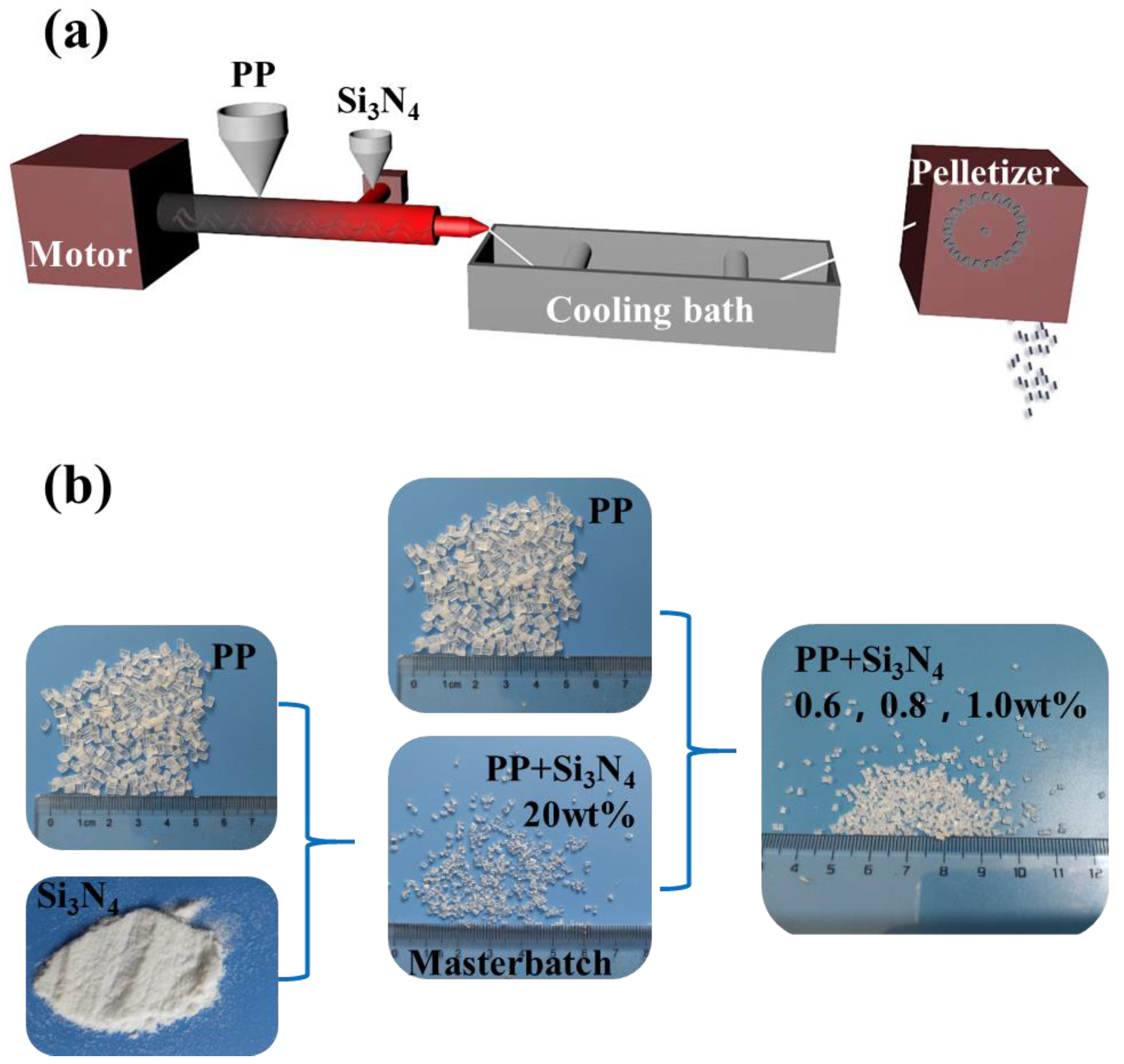
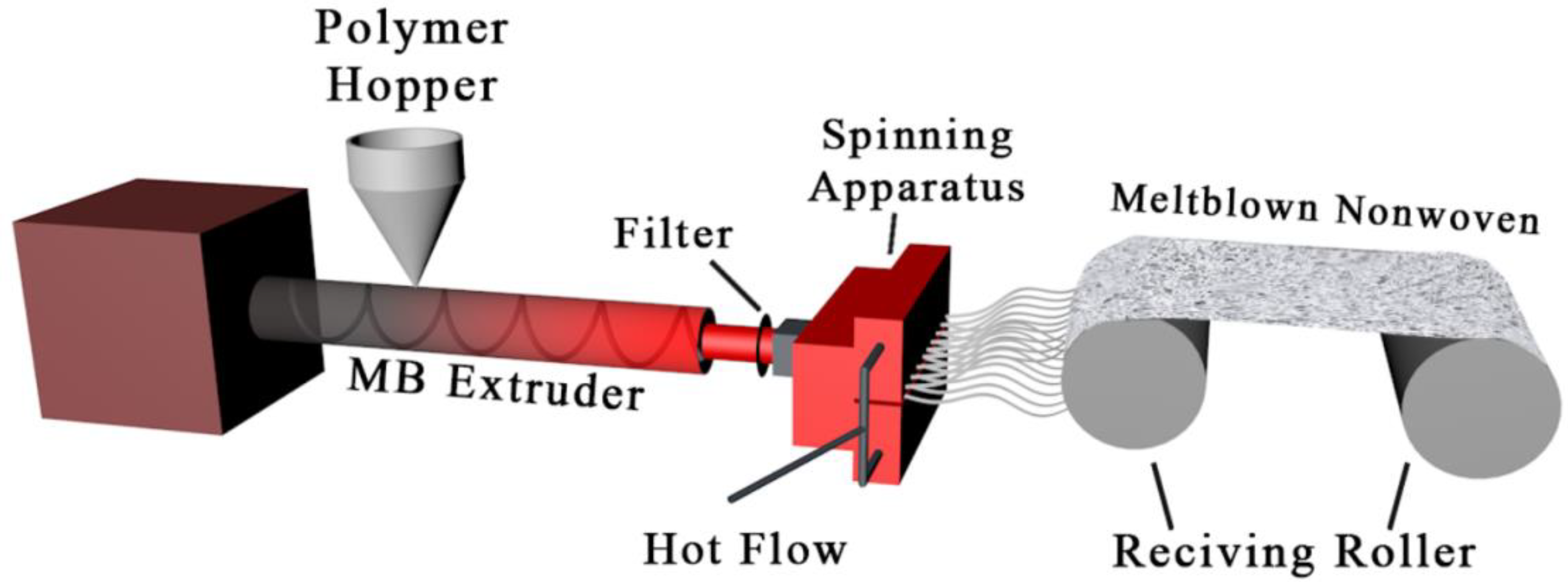

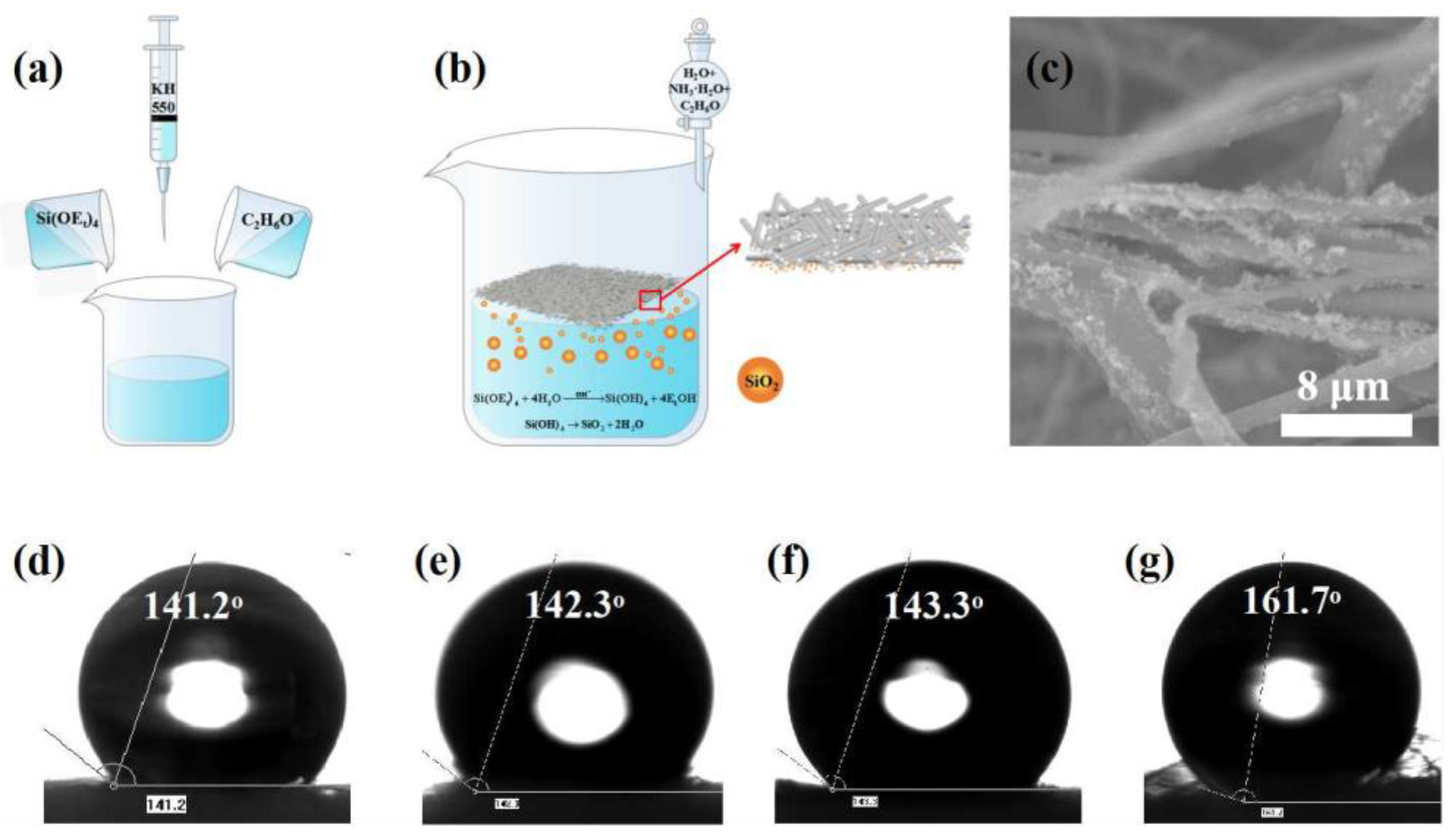

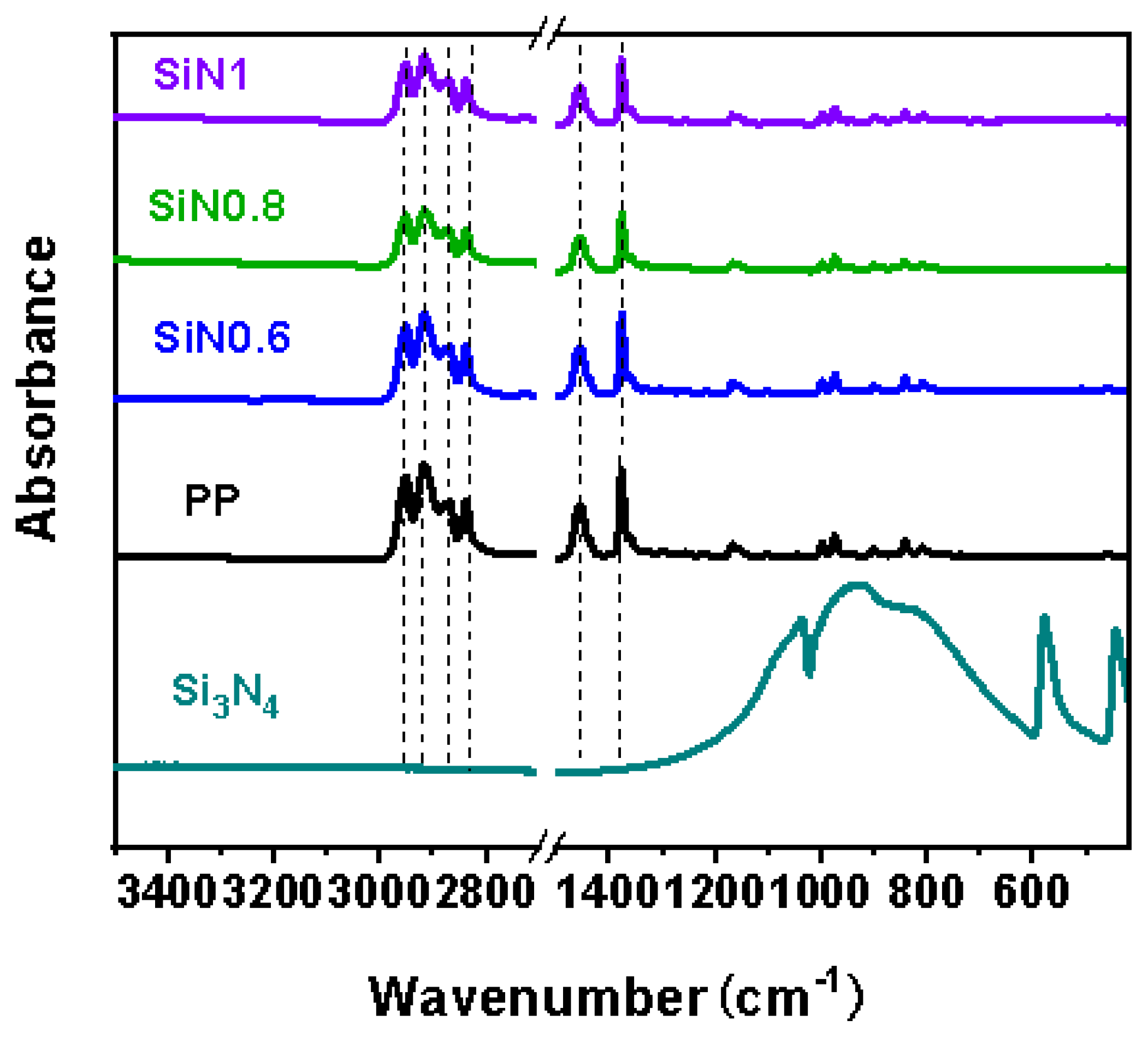
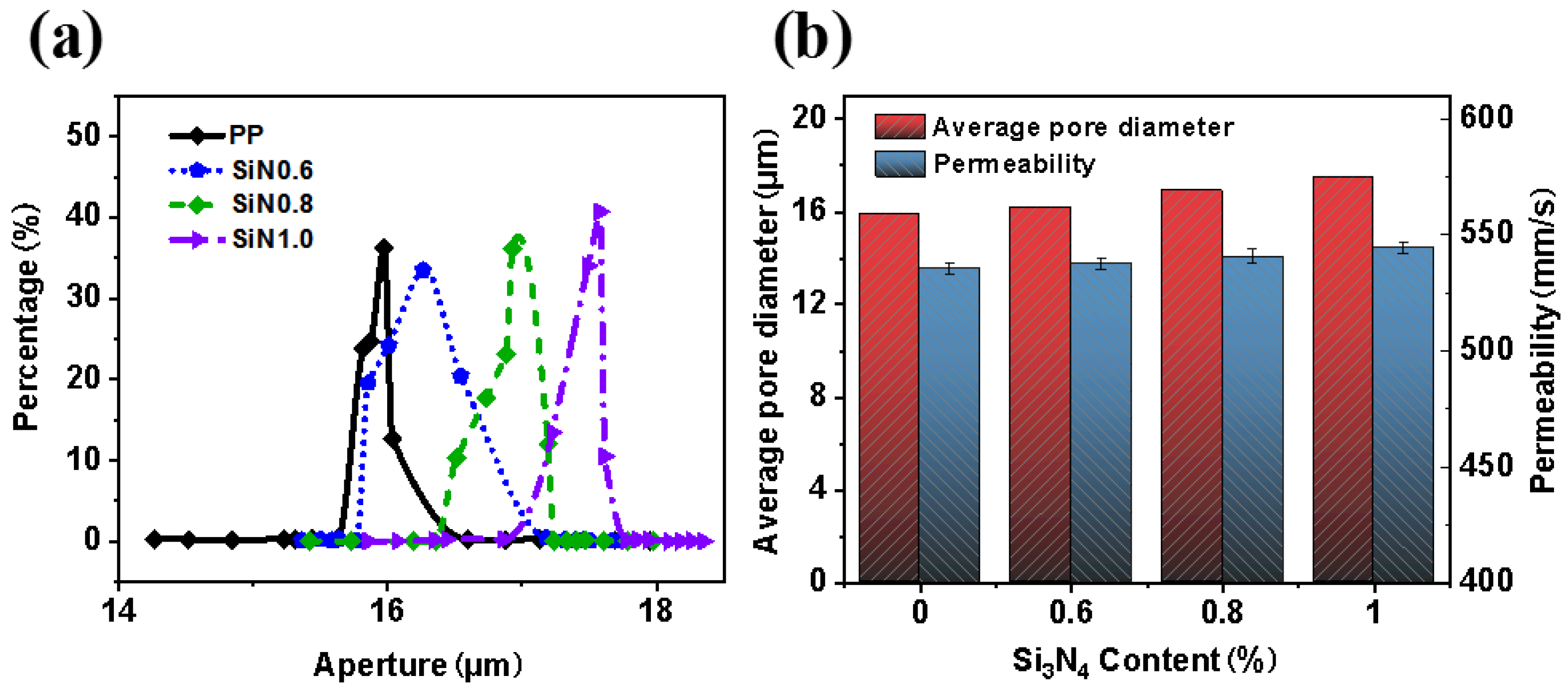
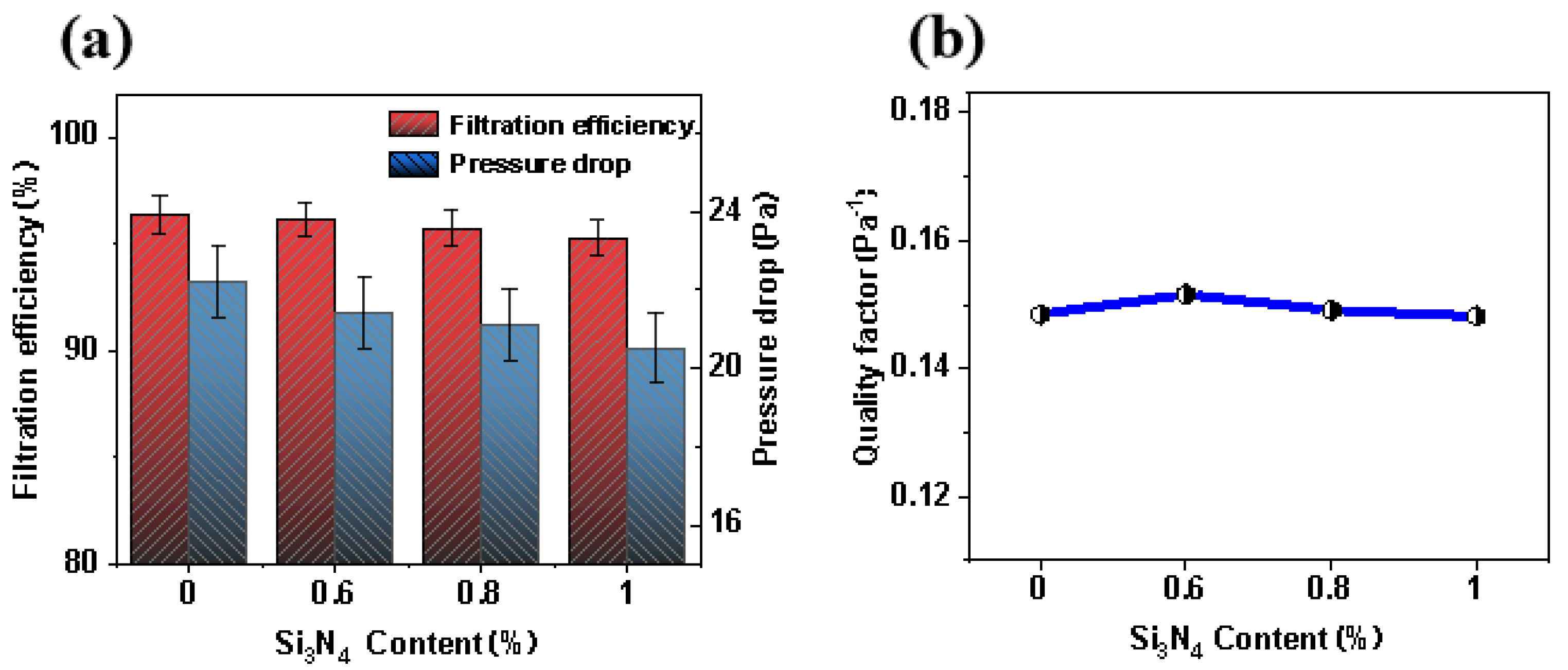
| Raw Materials | SiN0.6 | SiN0.8 | SiN1.0 |
|---|---|---|---|
| PP, % | 97 | 96 | 95 |
| Antibacterial masterbatch (20% Si3N4) | 3 | 4 | 5 |
| Zone 1 and 2, °C | Zone 3 and 4, °C | Zone 5 and 6, °C | Zone 7 and 8, °C | Zone 9 and 10, °C |
|---|---|---|---|---|
| 160 | 170 | 175 | 170 | 165 |
| Zone 1, °C | Zone 2, °C | Zone 3, °C | Zone 4, °C | Spinneret, °C | Hot Air, °C | Air Pressure, MPa | Distance to Roller, cm |
|---|---|---|---|---|---|---|---|
| 170 | 200 | 225 | 230 | 225 | 250 | 0.23 | 20 |
| Test Bacteria | (Wt), CUF/mL | SiN0 (Qt), CUF/mL | SiN0.6 (Qt), CUF/mL | SiN0.8 (Qt), CUF/mL | SiN1.0 (Qt), CUF/mL | SiN0 (Y), % | SiN0.6 (Y), % | SiN0.8 (Y), % | SiN1.0 (Y), % |
|---|---|---|---|---|---|---|---|---|---|
| Escherichia coli | 2.27 × 107 | 2.21 × 107 | 6.79 × 105 | 6.51 × 105 | 6.42 × 105 | 2.64 | 97.01 | 97.13 | 97.17 |
| Staphylococcus aureus | 2.71 × 107 | 2.62 × 107 | 7.89 × 105 | 7.68 × 105 | 7.55 × 105 | 3.32 | 97.09 | 97.17 | 97.21 |
Publisher’s Note: MDPI stays neutral with regard to jurisdictional claims in published maps and institutional affiliations. |
© 2022 by the authors. Licensee MDPI, Basel, Switzerland. This article is an open access article distributed under the terms and conditions of the Creative Commons Attribution (CC BY) license (https://creativecommons.org/licenses/by/4.0/).
Share and Cite
Han, M.-C.; Cai, S.-Z.; Wang, J.; He, H.-W. Single-Side Superhydrophobicity in Si3N4-Doped and SiO2-Treated Polypropylene Nonwoven Webs with Antibacterial Activity. Polymers 2022, 14, 2952. https://doi.org/10.3390/polym14142952
Han M-C, Cai S-Z, Wang J, He H-W. Single-Side Superhydrophobicity in Si3N4-Doped and SiO2-Treated Polypropylene Nonwoven Webs with Antibacterial Activity. Polymers. 2022; 14(14):2952. https://doi.org/10.3390/polym14142952
Chicago/Turabian StyleHan, Ming-Chao, Shun-Zhong Cai, Ji Wang, and Hong-Wei He. 2022. "Single-Side Superhydrophobicity in Si3N4-Doped and SiO2-Treated Polypropylene Nonwoven Webs with Antibacterial Activity" Polymers 14, no. 14: 2952. https://doi.org/10.3390/polym14142952
APA StyleHan, M.-C., Cai, S.-Z., Wang, J., & He, H.-W. (2022). Single-Side Superhydrophobicity in Si3N4-Doped and SiO2-Treated Polypropylene Nonwoven Webs with Antibacterial Activity. Polymers, 14(14), 2952. https://doi.org/10.3390/polym14142952





